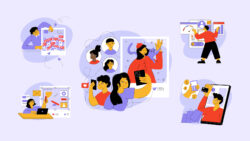If you teach PR, you already know that yesterday’s strategies won’t cut it in today’s classrooms. Outdated textbooks don’t keep up with the industry’s pace, and static content can leave students unprepared for real-world roles. To keep your course relevant and your students career-ready, you need flexible tools that evolve with the field.
This Stukent webinar, Preparing Students for PR Careers: Industry Insights & Classroom Strategies, explored how instructors can better align their courses with the skills the public relations field needs. If you missed it, here’s a quick recap with actionable strategies you can implement today.
Featured Panelists

Karen Freberg, a professor of toto slot strategic communications at the University of Louisville, directs The Bird’s Nest Student Agency. She brings expertise in social media, crisis communication, and applied learning. She is also the author of the Stukent “Personal Branding” courseware.

Jamie Ward, assistant professor at The University of Toledo, draws from more than a decade in the nonprofit sector and has coauthored several PR textbooks, including the Stukent “Public Relations Principles” courseware.

Randy’L Teton, a public affairs specialist slot zeus and award-winning author, offers a real-world perspective grounded in tribal relations, cultural communications, and government PR.
Actionable Teaching Strategies and Assignment Ideas
Here are five classroom strategies shared during the webinar to help you bridge the gap between coursework and real-world application in PR.
1. Community Engaged Learning
Public relations is all about building relationships, so why not help students practice by connecting with professionals in your local community? These activities help students build real-world communication skills and kickstart their professional networks.
- Community forum coordination: Randy’L Teton asks her students to plan and coordinate a local panel featuring civic and cultural leaders. Projects like this sharpen students’ networking, event planning, and communication skills while building valuable community connections.
- Guest speakers: Invite in-person or virtual guest speakers into your classroom to give students real-world insights through presentations, personal stories, and direct interaction with industry professionals. PRSSA can be a fantastic resource for this by getting students involved, building their confidence, and promoting opportunities.
- Corporate matchmaking: Teton encourages educators to use their connections to help bridge the gap between students and potential employers, a process she calls “being a corporate matchmaker.” By connecting standout students with local professionals, she not only opens doors to internships, mentorships, and job opportunities for students but also helps businesses discover emerging talent.
2. High-Stakes Practice
Real-world workplaces can be high pressure and high stakes. What better way to prepare students for these scenarios than through simulated challenges in a low-risk environment?
Jamie Ward brings PR crises to life by pairing her students with journalism majors. On camera, the PR students face unscripted, hard-hitting questions from journalism students acting as reporters, reinforcing the fundamentals of media training, crisis ethics, and professionalism under pressure. Ward says she also uses tools such as “SignalAI to bring [in] crisis simulations, guest speakers, case studies, etc., building the classroom around those experiences so students get as much practical content as they can.”
By transforming theory into authentic practice, Ward ensures her students graduate with more than knowledge — they leave with the confidence, composure, and critical thinking skills to navigate any PR storm. It’s a tactic you can use in your classroom, too!
3. Real-World Projects
Once students master the basics, it’s time for them to put their skills into action. Long-form projects push them to combine everything they’ve learned — including content creation, performance measurement, and teamwork — into a single, high-impact effort. During the webinar, panelists shared strategies for guiding students through full-scale campaigns that mirror today’s PR landscape, including emerging AI tools and real-world client work.
For example, ask students to build a fully realized AI persona. Using tools like ChatGPT or Gemini, they can craft a voice, values, and niche for a virtual consumer. Then, they can use image generation tools such as Midjourney or DALL-E to bring their persona to life visually.
Students can now design a full PR campaign around their persona, complete with objectives, messaging strategy, target audience segmentation, media outreach plans, and measurable KPIs. This project encourages critical thinking about authenticity, messaging control, and the blurred lines between human and AI influence in modern media.
Karen Freberg also recommends offering students the opportunity to pitch a final project of their own design. Giving students choice helps them feel more invested in the learning process. “If you’re able to ignite [their] passion but also allow [students] to implement their skills in real time, it creates a well-rounded experience,” Freberg says. Whether it’s a niche nonprofit or a campaign concept tied to a cause they care about, students often go above and beyond when given the space to connect classroom learning to a cause that is meaningful to them.
Finally, one of the most impactful ways to simulate real-world experience is through student-run agencies. These programs give students the opportunity to work with real clients in a structured, low-risk environment. Whether housed in a course or operated as an extracurricular activity, student agencies sharpen teamwork, client communication, project management, and presentation skills.
4. Ethical AI
With AI tools more integrated than ever into PR workflows, students must be prepared to use them responsibly.
A powerful way to engage students in responsible AI use is by having them develop ethical AI policies for their campaigns and content. These guidelines help them use AI strategically, avoiding overreliance while protecting learning outcomes. The result? Students learn to use AI effectively, building integrity, efficiency, and innovation. This assignment also sparks important conversations about professionalism, transparency, and using AI responsibly without sacrificing creativity or speed.
5. Analysis Tools
Have students do hands-on work with data analytics and professional tools to give them an advantage once they get into the field.
Ward pointed out a common gap in PR education — data and analytics. She emphasized the value of giving students hands-on experience with real-world tools to track KPIs and measure campaign performance, skills that make them more marketable and job-ready.
Ward’s students gain experience in platforms such as Google Analytics, Brandwatch, and Hootsuite. By mastering these tools before graduation, students leave the classroom with the analytical expertise employers demand and the confidence to put it to work on day one.
What Employers Want from New Grads
So, what do employers really want in new PR hires? According to our panelists, technical skills are nonnegotiable, and writing remains the bedrock of the profession. Strong grammar and clear communication are expected.
Panelists also stressed the importance of AI literacy. Ward explained, “Before graduating, students need to understand the intricacies of AI — not just how to create content, but how to interpret data and use these tools to manage real campaigns effectively.”
Soft skills are just as critical as technical expertise. The ability to build trust, connect with diverse audiences, and collaborate effectively can set candidates apart. Panelists also highlighted the importance of being teachable and open to feedback. In PR, learning doesn’t end at graduation. Practitioners who ask questions, adapt quickly, and grow on the job are the ones who thrive.
Watch the Webinar for More Insights
If you appreciated this glimpse of the panelists’ insights, the full recording takes a deeper dive into practical strategies you can put to work right away. Watch the webinar to discover more ways you can use real-world learning to boost student engagement and career readiness in your PR course.






